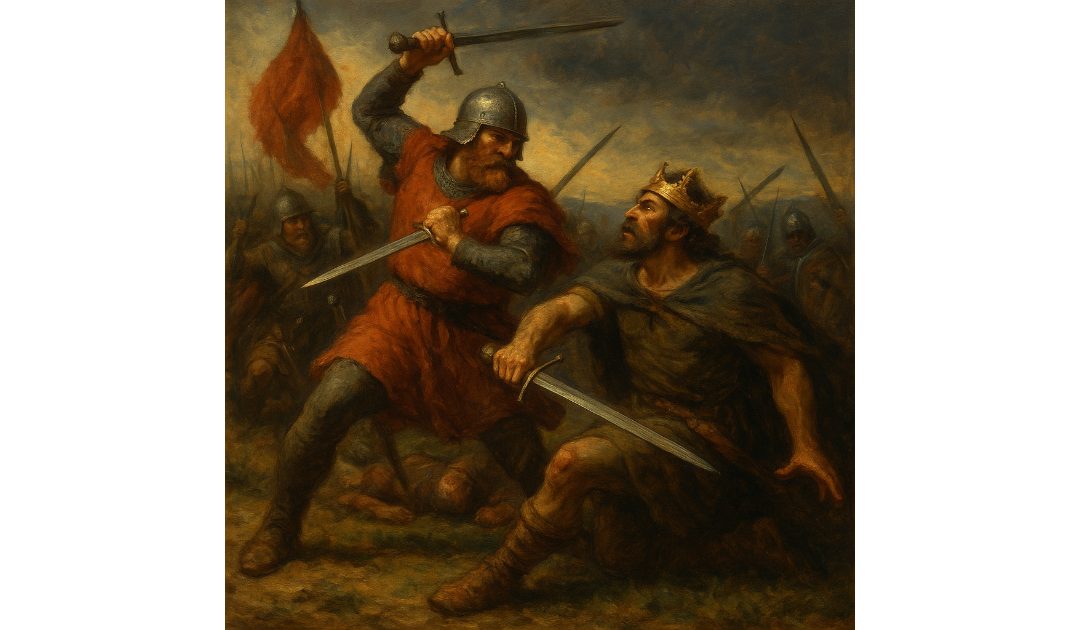The Battle of Dunsinane was fought on the 27th of July, 1054, and Siward, Earl of Northumbria defeated Macbeth, King of Scotland. William Shakespeare’s Macbeth is a renowned tragedy that draws loosely from the historical figure Macbeth, who reigned as King of Scots from 1040 to 1057. While Shakespeare’s play provides a dramatic, dark, and supernatural narrative, the true story of Macbeth presents a more nuanced figure, whose life contrasts significantly with the playwright’s depiction.
Historical Background of Macbeth:
The real Macbeth, known in Gaelic as Mac Bethad mac Findlaích, was born around 1005. He was the son of Findláech of Moray, a descendant of the royal line, and through his lineage, he had a legitimate claim to the Scottish throne. Macbeth became King of Scots after defeating King Duncan I in battle in 1040. Historical records suggest that Duncan was a young and possibly ineffective ruler, and his death occurred amid the struggles typical of medieval Scottish succession disputes.
Macbeth’s reign lasted for 17 years, a period marked by relative stability and prosperity, which stands in stark contrast to Shakespeare’s portrayal of a tyrannical, guilt-ridden ruler. Historical accounts describe Macbeth as a competent leader who introduced reforms, promoted Christianity, and even undertook a pilgrimage to Rome—a significant feat reflecting his secure rule and pious inclinations.
Shakespeare’s Macbeth:
In Shakespeare’s version, Macbeth is depicted as a valiant Scottish general whose encounter with three witches sparks an insatiable ambition to become king. Spurred by the prophetic words of the witches and the manipulative encouragement of his wife, Lady Macbeth, he murders King Duncan in his sleep to seize the throne. This act sets Macbeth on a path of paranoia, tyranny, and further bloodshed, culminating in his downfall.
Shakespeare’s Macbeth is tormented by guilt and fear, leading to hallucinations and erratic behaviour. His reign is characterised by despotism and relentless violence, a sharp deviation from historical records. The play concludes with Macbeth’s death at the hands of Macduff, restoring order to Scotland.
Key Differences Between Fact and Fiction:
Duncan’s Death: Historically, Duncan I died in battle against Macbeth’s forces, not through assassination. He was probably older and less effective as a ruler than depicted in the play, where he is portrayed as wise and benevolent. Shakespeare’s dramatic choice heightens the tragedy of Macbeth’s betrayal.
Macbeth’s Character: The real Macbeth was an effective ruler with a stable reign, whereas Shakespeare’s Macbeth is a tragic figure doomed by ambition and moral weakness. The historical Macbeth’s pilgrimage to Rome indicates a ruler confident in his reign, contrasting sharply with the insecure usurper in the play.
Lady Macbeth: There is limited historical information about Macbeth’s wife, Gruoch, who had noble lineage and was previously married. Shakespeare’s Lady Macbeth is a pivotal character, portrayed as fiercely ambitious and influential in her husband’s moral decline. Her complex character adds psychological depth to the play, embodying themes of guilt and madness.
The Witches and Supernatural Elements: The inclusion of the witches and supernatural elements serves Shakespeare’s dramatic purposes, reflecting the Jacobean audience’s fascination with witchcraft and the occult. These elements have no basis in historical accounts but are integral to the play’s exploration of fate and ambition.
Banquo’s Portrayal: Historically, Banquo’s existence is dubious, and he may have been a fictional creation. In the play, Banquo is depicted as a noble, morally upright figure, contrasting with Macbeth’s descent into treachery. This portrayal served to flatter King James I, believed to be a descendant of Banquo.
Reasons for Shakespeare’s Adaptations:
Shakespeare wrote Macbeth during King James I’s reign, a monarch with Scottish heritage and an interest in witchcraft. The play’s themes and characterisations were probably crafted to appeal to James, emphasising the divine right of kings and the disastrous consequences of regicide. The dramatic liberties taken by Shakespeare enhance the narrative’s tension, moral lessons, and tragic impact.
In conclusion, while Shakespeare’s Macbeth is rooted in historical events, it diverges significantly from factual accounts to serve dramatic, thematic, and political purposes. The real Macbeth’s legacy as a capable ruler contrasts sharply with the tragic figure immortalised in one of Shakespeare’s most enduring plays.

